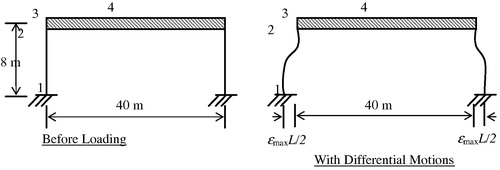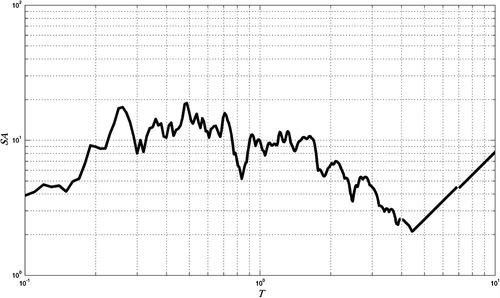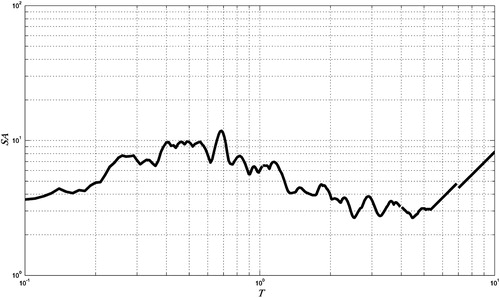 ?Mathematical formulae have been encoded as MathML and are displayed in this HTML version using MathJax in order to improve their display. Uncheck the box to turn MathJax off. This feature requires Javascript. Click on a formula to zoom.
?Mathematical formulae have been encoded as MathML and are displayed in this HTML version using MathJax in order to improve their display. Uncheck the box to turn MathJax off. This feature requires Javascript. Click on a formula to zoom.Abstract
Differential motions of ground supports of stiff structures with large plan dimensions and separate foundations under earthquakes were studied by researchers during the last few decades. Such a type of structural response was previously underestimated. The importance of studying such a response comes up from the fact that usually the structures affected are of strategic importance such as bridges. During their expected life, structures may experience vibrations excited by ground waves of short wavelengths during near-source earthquakes, or during amplified earthquake signals, during explosions, or during vibrations induced from nearby strong vibration sources. This is the case when the differential motion of supports becomes considerable. This paper aims to review the effects of seismic signal variations along the structures dimensions with emphasis on Egypt as a case study. The paper shows some patterns of the damage imposed by such differential motion. A replication of the differential motion in the longitudinal direction is applied on a frame bridge model. The resulting straining actions show the necessity for considering the differential motion of supports in the design of special structures in Egypt. Finally, response spectra for the differential motion of supports, based on the available data from previous earthquakes in Egypt, is derived and proposed for designers to include in the design procedure when accounting for such type of structural response, and especially in long-span bridges.
Introduction
Several damaging earthquakes have been reported in Egypt in recent and historical times [Citation1]. Moreover, past significant earthquakes have seriously damaged a lot of structures. Such damage usually varied considerably from one location to another, even if two of the studied structures were similar and with a small distance in between [Citation2]. This variation in the structural damage, according to the reliability theory, may be attributed to the differences in structural strength and the ground motion amplitude at these two separate locations [Citation3]. Moreover, non-uniform seismic excitation has been shown through previous analytical studies [Citation4–Citation24] to adversely affect the response of long-span structures such as bridges. Furthermore, on studying the structural response under earthquakes and neglecting the soil-structure interaction, a collection of phenomena that are caused by the flexibility of the surrounding soil interacting with the structures foundations are missed.
Based on the above facts, one can distinguish that one of the important seismic response behaviors during earthquakes, or during near-source strong vibrations, is the differential motion of structures foundations with large spans. Such response behavior needs more emphasis in the design codes in Egypt. This type of motions of structures foundations may exist severely in the near field of moderate and severe earthquakes (e.g. moderate as Cairo earthquake in Egypt, 1992, and severe as Nuwaibaa earthquake in Egypt, 1995). What adds to the necessity of considering such a response type is knowing that the most affected structures in that case are long structures with large spans such as bridges, which upon their loss would infer human life losses as well as huge economic impacts.
In addition, since the occurrence of the Cairo earthquake on October 1992, the design of structures for earthquakes became a major demand enforced in the Egyptian design codes. However, despite that the Egyptian Code for Soil Mechanics, design and construction of Foundations (ECSMF) [Citation25], and the Egyptian Code of Loads on Structures (ECL) [Citation26] give more attention to earthquake response details than those found in the other older equivalent Egyptian design codes, yet, the subject of the differential motion of supports is still undermined. For example, the study of the effects of such supports motions in the ECSMF [Citation25] is only restricted to applications on pipelines design without any remark discussing the potential of having such seismic response aspect in long structures. Also, the ECL [Citation26] refers to the issue in Item (8-4-4) but with no sufficient details for designers. As a result of that, it is expected that structural engineers are not clearly required to consider such differential motions in design.
Problem definition
The problem herein arises from the fact that the differential motions of supports may lead to the generation of considerable moments and shear forces in the bridge deck level and subsequently the formation of plastic hinges at the bridge columns upper ends. Accordingly, such additional forces and straining actions add to the effects of the structural dynamic response. Therefore, larger drifts at the bridge deck level are expected. The latter result would thus require higher ductility that may not be well enough in the bridge structures affected. Unfortunately, the concerned structures may include bridges or long structures of similar effective importance which upon being damaged may infer loss of lives and huge economical losses.
This paper reflects the importance of considering the differential ground motion of supports of large structures during the design phase and shows some patterns of the damage that may be imposed by these motions. In addition, an analysis is performed on a frame bridge model to show the resulting added straining actions. Finally and most important, response spectra for the differential motion of supports based on data from previous earthquakes in Egypt, acting on a single story structure (e.g. Bridges), are derived to represent a reference for the Egyptian designers to include in design.
Literature overview summary
In the majority of older studies in the earlier decades of the 20th century concerning structures response during earthquakes, the effects of the differential motions of ground supports were usually assumed small [Citation11]. In spite of that, the significance of differential motions for long structures has been studied in the last few decades with different approaches such as in references [Citation4,Citation9,Citation14–Citation18]. Moreover, other research efforts studied the differential ground motion effect on bridges [Citation4,Citation6,Citation13,Citation20,Citation21]. In contrast, seismologists study the problem but with different approaches of solution. However, the data from a seismologist is not useful in structural design since it is based on distances that are very far apart to evaluate the differential ground motion.
Generally, in regions near seismic faults where the amplitudes of ground motion are significantly large [Citation22–Citation24], the contribution of these motions, when taking place together with the inertial forces, can be really annoying [Citation11,Citation16]. The same result may also be expected for amplified earthquake signals resulting from local soft soil conditions. The latter studies have shown that the quasi-static strains in long structures may dominate in contributing to the peak stresses and deformations and that the resulting distributions of stresses may be very different from those predicted by inertial effects alone. In spite of that, Trifunac [Citation11] referred that when the design conditions or local codes call for connecting grade beams and slabs between individual column foundations, certain components of the differential motion of the first story columns may be reduced or eliminated. This depends in turn on the possibility of connecting the supports (e.g. bridges supports can rarely be connected via ties) as well as on the relative rigidity of the inter-connecting slabs and beams. In addition, this may depend also on the components of motion excited by strong motion waves.
Differential motion of supports, its aspects and implications
Many observers reported having seen ground waves during earthquakes [Citation27]. This suggests that locally, large relative displacement amplitudes, short wave lengths and “slow propagation” velocities do exist, though sometimes this may be the effect of some non-linear site response [Citation23]. and show two of the expected differential motions of supports that may be induced in long structures due to the effect of Rayleigh waves and Love waves with small wavelengths.
Fig. 1 Deformation of columns as a result of Love waves with short wave lengths [Citation11].
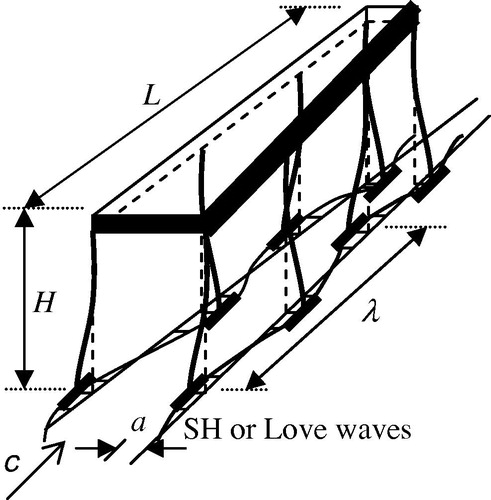
Fig. 2 Deformation of columns as a result of Rayleigh waves with short wave lengths [Citation11].
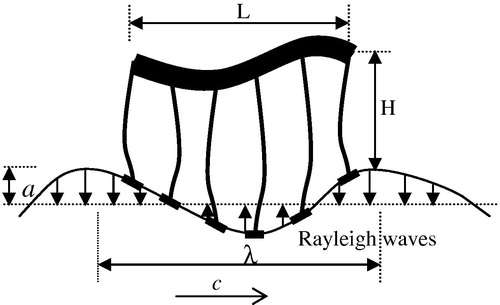
Damage inferred by differential motion of supports
Looking at the previous damages that were initiated during the previous near-source earthquakes (e.g. San Fernando Valley earthquake in California, 1971, and Northridge earthquake, 1994), one would observe severe damages in the first story in some of the long structures [Citation28,Citation29]. This would imply that the differential motion between supports of structures are big to the extent that structures suffer a soft first story collapse mechanism even with being designed to be earthquake resistant. Accordingly, not considering the differential ground motion in design can be devastating to some structures. The tragedy lies in the fact that large structures, which are usually very important after earthquakes such as bridges, are the ones that are severely affected.
The effect of the structural properties and site soil properties on differential motions of supports
In order to analyze structures vibrations, default dynamic models usually consider uniform translation of the foundations. However, for ground excitations that have short wavelengths relative to the foundation dimensions, the dynamic models used in the response analyses should include the nature of such wave excitations as well. Including that in the analysis depends on the properties of the structure and the nature of its contact with the ground. This contact can be over an extended surface or near surface area as this is the case for most structures [Citation15]. Also, the contact may be along an irregular canyon surface, as for various dam structures [Citation30], or it may be along a discrete set of points, as for many bridge structures [Citation21]. In each of these previous cases, the response will depend on the detailed dynamic properties of the structure and on the variation of the excitation at different foundation points. Moreover, differential motions between the structures’ supports are clearly reflected in case of foundations lying on soft soil [Citation31] (N.B.: this is the case for Cairo and all Egyptian Delta cities) where the differential motions are related to the corresponding strains, ɛ near the ground surface [Citation31,Citation32] by(1)
(1) where vmax is the peak ground velocity of the soil particle and vs is the average shear wave velocity near the surface. Consequently, it is seen that the differential motions will be large when vmax is large and vs is small. This accordingly applies to soft soil sites [Citation17,Citation33]. The empirical scaling function A(d) depends on the separation distance between the supports, d, on the variation of shear wave velocity with depth, β, as well as on the mechanism of motion and distance to earthquake sources.
Furthermore, the soil may have a nonlinear behavior that would dissipate the arriving energy by incident waves. Trifunac and Todorovska (1999) [Citation23] studied the damage due to San Fernando valley earthquake and found that the areas with a high density reported breaks in water pipes in typical residential areas in San Fernando and in Los Angeles often did not coincide with the areas having a high density of severely damaged buildings. This observation indicated that damage of buildings in some areas might have been smaller than expected because the soil dissipated part of the energy of the ground motion by nonlinear response. Moreover, the authors of the latter study interpreted that the number of severely damaged buildings was reduced in areas where the surface soils experienced some form of non-linear response (assumed for ɛ < 10−2.5) because the soil absorbs part of the incident waves energy. In the areas where the strains of the soil were very large (assumed for ɛ > 10−2.5), or where the soil failed (slope failures, ground cracking, compressive failures, tension cracks, etc.), large differential ground motions took place and deformed the building foundations, resulting in pseudo-static damage of the building in addition to the damage caused by large inertial forces [Citation23]. In consequence, one would expect that the negative effect of larger ground strains should be more significant for large in-plan buildings.
At sites, where the near surface soil responded linearly, the observed amplification of strong motion may be explained by focusing and interference of incident waves. The locations on the ground surface where the focusing and interference of seismic waves increase or decrease the amplitudes of the incident waves depend on the angle of the arriving waves and on the geometry of the sediments and of the soil deposits [Citation23].
Moreover, Heredia-Zavoni and Barranco [Citation34] discussed the torsion in symmetric structures due to ground-motion spatial variation resulting from loss of coherence, wave passage, and local soil conditions. The results have shown the influence of local soil conditions and incoherence effects on the torsion response. Large eccentricities are found for highly incoherent support ground motions. Maximum eccentricities develop at those fundamental periods that are close to the predominant period of the ground as support ground motions become less correlated. Thus, peak eccentricities can be expected for rigid structures on firm soils, and as for soft soils, maximum eccentricities will develop for relatively more flexible systems [Citation34]. A comparison of the American codes torsion provisions has shown that, depending on the period and aspect ratio of the system, on the local soil conditions, and on the times for seismic waves to travel across the base of the system, eccentricities can exceed the standard code prescribed values of 5% and 10% [Citation34].
The effect of differential motion of supports on bridges
Of all structures, bridges in particular are the ones most affected. This is due to the fact that most bridges have long span continuous beams along their longitudinal axis. Thus, one should expect that the distances between supports along the longitudinal axis are big enough that the differential relative motions between supports are expected to severely exist. Furthermore, bridges do sometimes have supports on different types of soils. This is the case for bridges crossing canyons, valleys or rivers. The problem lies in the fact that the exciting waves coming from the source in softer soils do not transmit their energy content to the stiffer types of soil [Citation35]. Thus, one gets reflected waves coming from the vertical separating plane between the two types of soil. This in turn intensifies the energy release in the sedimentary areas of the valleys or canyons. This would cause a tremendous amount of damage for a case study bridge having its corner supports on hills (or in particular stiffer soil strata), and having intermediate supports in between that are supported on the sides of the valley. This damage is due to the fact that the part of the bridge supported on stiff soil barely gets excited by the waves, whereas the intermediate parts are heavily excited in opposite directions.
Moreover, Kashefi and Trifunac [Citation21] studied the dynamic response of a three-dimensional bridge model for a two-span simply supported bridge. The model is erected on the elastic half-space and is subjected to incident plane wave excitations. The normalized maximum relative rocking of the columns and the relative sliding of the girders were studied. The results have been obtained for different incident angles and natural frequencies of the system. All results indicated that the maximum relative rocking responses of the columns increase when the excitation frequency increases. In addition, for large excitation frequencies, these peak responses tend to increase linearly. It is also shown that the response of the columns on soft soil for high frequency of excitations is more than that for similar excitations for columns on stiff soil. Moreover, the maximum relative sliding of the girders experiences local maxima when the ratio of the span to the apparent wavelength of the incident waves is 1.5, 2.5 and 3.5. Such maxima correspond to cases when the columns response is out of phase.
Also, Deodatis et al. [Citation13] studied the seismic response of bridges to differential support ground motion. A total of 18 scenario earthquakes were considered by varying the velocity of seismic wave propagation, v, the angle of incidence of seismic waves with respect to the axis of the bridge, θ, and by considering combinations of horizontal and vertical components of ground motions. For each scenario, the structure was analyzed using identical and differential support ground motion. It is assumed that the motion of interest is the motion of the centre axis of the bridge. Thus, the structure was modeled with 1-D frame elements extending along the centroid of the studied superstructure box girder. The section properties of these elements are chosen to represent the full width and depth of the box girder. Accordingly, it was shown that certain sections of the deck experienced maximum stress increases of the order of 16–18% when analyzed using spatially varying ground motion compared to the corresponding dynamic analysis using identical support ground motion.
In addition to the above studies, it is found that during Northridge earthquake, a lot of freeway bridges were severely affected. In the damage assessment report edited by Hall (1995) [Citation29], it is observed that differential motion of supports may have been the cause of some recorded damage. As another example, during the San Fernando Valley earthquake in 1971, severe damage is observed at the crossing exchange of the I-5 (golden state freeway) and the I-210 (Foothills freeway). Structural damage varied, from minor damage to wing walls and slope paving, to rotation and settlement of abutments, splaying and cracking of columns, displacement of wing walls, and failure of the sides of landfills. shows failures of three of the spirally-wrapped columns that provided the central support of this I-5 and I-210 overpass. It is clear that the third column from right is almost not damaged whereas the first two columns from the right have intensified damage which may have been due to relative motion that occurred to the main structure at its supports.
Fig. 3 Column failure at an overpass (Foothills Freeway crossing Foothills Boulevard) as a result of the San Fernando earthquake of 1971 (http://www.ngdc.noaa.gov).
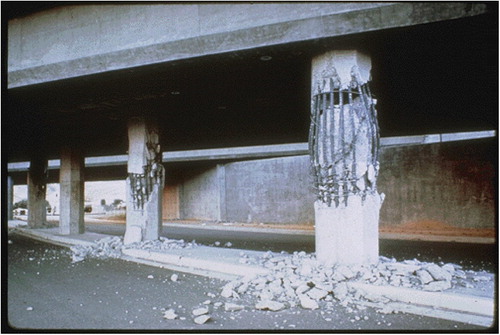
Studying the potential of having differential motion of structures supports in Egypt
At present, it is not hard to figure out that considering the properties of the propagating waves which excite extended structures, and the resulting differential motions of supports, have not been discussed thoroughly by design codes [Citation25,Citation26] or structures designers in Egypt. Accordingly, due to previous damage recognitions resulting from such phenomenon, one feels driven to study the potential of having such differential motions in structures in Egypt during the expected earthquakes.
Moreover, on the basis of earthquake distribution, Egypt can be divided into two tectonic provinces: Northern Egypt (North of latitude 26°) and Southern Egypt (South of latitude 26°). The first province is more seismically active than the second one, where the spatial distribution of earthquake epicenters in Egypt suggests that the main activity occurs in the northern part of the Egyptian territory [Citation36]. Bearing that in mind and studying the case of the Nile Delta (e.g. greater Cairo area (GCA)) within the last two decades, one can observe that during the Cairo earthquake of October 1992, the structures in GCA were clearly affected and many of them suffered considerable damage. In addition, during the earthquake that occurred in Nuwaibaa in November 1995, the structures in GCA as well underwent considerable shaking but with no evident damage [Citation37]. This may have been due to site seismic wave amplification [Citation37–Citation39], and may have been attributed in some cases to poor design or construction.
In general, the main occupied land by Egyptians is the Nile Delta. Thus, the capital of Egypt as well as many major cities lies in this geographic zone. From a geologic perspective, the soil of the Nile Delta is considered made of alluvium. Alluvium is loose gravel, sand, silt, or clay deposited by river streams such as the River Nile. Therefore, the peak soil strains due to earthquakes should be studied for such a soil type and the resulting relative motions should be evaluated in order to find the expected additional straining actions. However, the extra loading risk due to differential motions of supports only exist if the wavelength of the exciting waves is less than or equal to the span between supports. In the case study here, a sample frame bridge is considered. The span of the frame bridge is assumed equal to 40 m. and the height of its columns is assumed 8 m. as shown in . These are reasonable estimates when compared to the actual bridges spans that may exist in Cairo and considering the allowable truck heights passing underneath bridges plus the foundation depth. In addition, the span estimate was limited to 40 m to show that bridges with such moderate span lengths may suffer from differential motion of supports. The columns of the frame herein are assumed massless as shown in . Furthermore, it is also assumed that the waves propagate along the longitudinal axis of the bridge. In this problem, only the horizontal component of relative motion of foundations is illustrated. This in turn is approximated by peak relative displacement from Eq. (1) such that:(2)
(2) where L is the distance between the end columns. As the span, L, becomes comparable to c × T, where T is the predominant period of the ground motions and c is the speed of the propagating waves, then the differential motions takes place and causes extra straining actions.
Analysis of results
The knowledge of peak velocities is essential for the computation of peak amplitudes of near surface strains in soils [Citation33]. However, since no previous measurements are available from previous earthquakes in Egypt, one is obliged to look for similar cases of the Nile delta. Thus, it may be observed that similar conditions exist in the Duwamish River delta in Seattle, USA. The USGS (United States Geophysical Survey, http://www.earthquake.usgs.gov) [Citation40] describes the Duwamish River delta, Seatle, Washington state, as composed of a 90 m thickness of alluvium and recent fill. Moreover, the USGS defines the shear wave velocity, vs, in this area to be equivalent to 100–175 m/s [Citation41]. The latter case should be similar to the case of what could be observed in the Nile delta. Thus, by considering an earthquake like the famous Cairo earthquake (October, 1992), which had an epicenter that was close to the Cairo metropolitan area, then the peak soil particle velocities are relatively large to the case of other distinct areas from the epicenter. The peak velocities can thus be estimated from Elsayed et al. [Citation42] to be in the range of 18–30 cm/s, corresponding to the highest peak velocities in the Nile Delta. Thus, by assuming a peak velocity of 22.5 cm/s and dividing this value by an average shear wave velocity of 137.5 m/s and assuming A(40) in Eq. (1) equivalent to 1 [Citation33]. Thus, the expected peak strain is equivalent to 0.00163 and the corresponding longitudinal deformation is thus equivalent to 6.52 cm. The resulting bending moments and shearing forces due to such differential deformation are shown in . Moreover, by assuming the natural period of the single story frame bridge structure as 0.1 s, then the velocity in the longitudinal direction, c, can be obtained from [Citation42],(3)
(3) to be 302.75 m/s for the peak shear wave velocity as the worst case scenario. Thus, the least span that can be affected by differential ground motion is 30.2 m which is smaller than the bridge span in the case study.
Table 1 Additional bending moments and shear forces at specific points in the frame model due to differential longitudinal motion between the columns.
The above results in indicate the potential of having extra internal forces in the structural members due to the differential motion of supports. This therefore highlights the importance of considering such phenomenon upon design of bridges or similar structures. It is thus suggested to include a friendly tool such as the response spectra curves for considering the differential motion of structures in the design procedure.
Derivation of response spectra for the differential motion of bridge supports
Because of the fact that the Response Spectra (RS) is a practical tool for structures’ designers, it would be reasonable to derive the response spectra for the differential motion of supports especially from the available data of earthquakes that took place in Egypt. In addition, one needs to consider a suitable model to reflect the nature of the bridge structures of being extended in the longitudinal direction with large spans. In order to do that, it would be reasonable to consider the bridge as a single rigid mass connected over many column supports and excited horizontally along the longitudinal direction [Citation12]. The scattering and inertial interactions are neglected in the adopted model. Trifunac and Todorovska [Citation10,Citation12] showed how to obtain the differential motion spectra in terms of the standard relative displacement spectra, the peak ground velocity, a factor dependent on the distance of the column from a reference point, and on the shear wave velocity in the top soil layers. Furthermore, since we assume the bridge model as a symmetrical single-story structure on multiple columns, then it would be appropriate to approximate the response by the first mode.
Looking at the schematic of the adopted model in the analysis, as shown in , H, represents the height of the bridge vertical supports (height of the structure), u, represents the response of the rigid mass of the deck of the bridge model whose natural period is T. Thus, by considering the result obtained in earlier sections in this paper, one could expect that expected strains in the soil would infer the potential of having differential motion between supports. Moreover, since the suggested bridge model consider a single degree of freedom (SDOF) for the bridge deck then considering the linear equation of motion for a SDOF structure excited by a synchronous ground acceleration, ,
(4)
(4) where ω is the circular natural frequency of the structure, ζ is the damping ratio, uo is the absolute displacement of the structure of a chosen reference point R as shown in and ur is the relative displacement with respect to the reference point R.
Also, it should be noted that the reference point, R, in the model studied herein is simply the point lying on the ground level and on the axis of symmetry of the structure. Thus, the peak of the relative response is simply the spectral displacement for the motion uo, SD(T, ζ). Accordingly, one can conclude that the relative displacements of the ith column is the difference between the relative displacements of the structure, ur, and the relative displacements at the bottom of the ith column, with respect to the reference point R.
In addition, Trifunac and Todorovska [Citation10,Citation12] showed that the ground displacement uo is a weighted average of the displacements of the bottoms of the different columns, ui, where the weighing factors are proportional to the stiffness of the different columns. These motions can be interrelated by the strain field in the ground. However, for a symmetrical structure in terms of structural layout as well as the stiffness of the different bridge columns, similar to the model adopted herein, then the reference ground point, R, is at the midspan of the bridge model as shown in . Thus, on letting xi denotes the distance of the ith column bottom from the reference point on the ground R, and cx denotes the phase velocity of the ground motion in the X-direction, one would conclude that if the distance of the farthest columns from the reference point is smaller than the wavelength of the exciting earthquake wave, cxT (where T is the predominant period of ground motions), then the displacement at the bottom of the ith column can be approximated by the second order Taylor series expansion of ui about uo [Citation10,Citation12] such that:(5)
(5) and consequently, the relative motion of the base of the ith column is,
(6)
(6)
Moreover, when the wave nature of the soil motion is ignored such as when the phase velocity along the X-direction, cx, is infinite, all will be equivalent to zero and the bases of all columns move consistently as uo. Therefore, in that case,
denotes the local relative motions caused by soil strains and wave passage.
Furthermore, in Eqs. (5) and (6), is related to the axial strain, ɛxx, which can be expressed as explained earlier in Eq. (1). Based on that, one can conclude that:
(7)
(7) where
(8)
(8) and that is the time (multiplied by the factor A) that a horizontally propagating wave with a velocity,
, takes to travel between the reference point, R, and the ith column base.
In a similar manner, one can conclude that,(9)
(9) where
is the acceleration of the ground. Therefore,
(10)
(10)
Consequently, it can be shown that the resulting shear force resulting from differential motion on the ith column of a one story (SDOF) structure can be obtained from:(11)
(11) where ki is the lateral stiffness of the ith column.
Moreover, Trifunac and Todorovska [10] defined a three parameter relative displacement spectrum as,(12)
(12)
The latter spectrum can be computed during data processing and provided to the designer for usage. Thus, for a particular structure, τ can be evaluated for the different columns and read the maximum relative displacement from the exciting earthquake response spectrum. Furthermore, an approximation for the SDC-spectrum in the above equation can be derived in the equation [Citation10,Citation12]:(13)
(13) where SD(T, ζ) is the classical spectral displacement and vmax and amax are the peak velocity and acceleration of the motion of the reference point R. Moreover, the factor, δ, is taken equivalent to one for single story structures. Furthermore, Trifunac and Todorovska [Citation10,Citation12] showed that the approximation in the above equation is very close to exact evaluations and that the contribution of the higher terms including the peak acceleration is usually small and can be neglected.
Differential motion response spectra based on previous earthquakes in Egypt
As stated above, the ground motion amplification and high level of damages over soft soil and unconsolidated deposits have been responsible for increasing the earthquake intensity than in the case of consolidated and hard sediments [Citation37]. Thus, since the ground motion may be considerably amplified by the soft soil layers, e.g. the Nile Delta, then this effect must be taken into consideration during the design and construction of structures and especially bridges. However, in order to mitigate the seismic risk (earthquake damages), the influence of the site effects (ground motion amplification factor and other corresponding aspects including differential motion) should be taken into account during design and construction. Given that, it is therefore advisory to use the available data of earthquakes in obtaining a design friendly tool as the RS for engineers to consider the effect of the differential motion of long structures supports in infrastructure deign e.g. bridges. As for Egypt as a case study, it should be even more beneficial to obtain the required response spectra for the Nile Delta, e.g. the crowded zones in GCA.
Historically, the GCA was hit by several moderate size earthquakes such as the earthquake that took place in the Fayum area on August 7th, 1847 (Fayum earthquake) which had an intensity of VII [Citation36]. In addition, on October 12th, 1992, a significant earthquake occurred southwest of Cairo in the vicinity of the Dahshour region, about 25 km SW of downtown Cairo. Unfortunately, none of these previous earthquakes records are officially available due to several reasons including the absence or unreadiness of suitable measuring instruments by the time of their occurrences.
In spite of that, structures in GCA underwent moderate shaking from the Nuwaibaa earthquake and this was attributed to the strong amplification of seismic motion over the thick, very soft Nile alluvium soils covering vast areas of the GCA [Citation36,Citation37]. The latter shaking may also be the result of one or several factors including the low attenuation experienced by earthquake waves transmitted from the Gulf of Aqaba through the basement rocks of Sinai and the Eastern Desert of Egypt, the strong amplification of seismic motion over the thick, very soft Nile alluvium layers in the Nile Delta [Citation36]. Furthermore, El-Difrawy in his analysis [Citation37] showed that the Peak Ground Accelerations (PGA) in some highly populated areas in GCA such as Shubra and Bulak may have reached 2.54 and 3.50 m/s2 (0.25 g, 0.35 g) respectively, as shown in [Citation37]. The PGA values in were stochastically simulated [Citation37] since no structures were reported instrumented for data collection by the time of the Nuwaibaa earthquake. To validate the assumed PGA values, the regional strong motion attenuation input to stochastic simulations was varied until the obtained soil acceleration time history in qualitatively agreed with syn-earthquake macroseismic phenomena from felt reports in both level and duration of shaking [Citation37].
Fig. 6 Simulated accelerograms of the Nuwaibaa earthquake over the soil of GCA by El-Difrawy [Citation37].
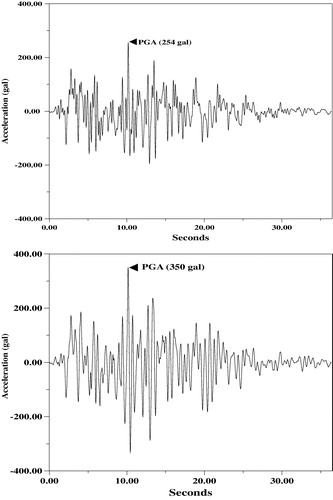
Another advantage for using the Nuwaibaa earthquake for the derivation of the spectral differential displacement curves is the fact that this earthquake was a major event (7.2 Richter), and thus included a wider frequency domain as shown in and . Accordingly, the recorded signals included considerable energy in the higher frequency domain implying the potential of having short wave lengths for the arriving waves to the studied sites.
Analysis of results
From an engineering point of view, infrastructure designers are more concerned about the structures response in the frequency range between 1 and 10 Hz [Citation36]. Thus, the high ground motion amplification factors at that frequency range play an important role in the seismic disasters. Thus, the acceleration response spectrum for a 5% damped Single Degree of Freedom (SDOF) oscillator with frequencies ranging from 0.1 to 10 Hz was simulated for the Nuwaibaa earthquake within the studied area (GCA) at the highest amplification site. The earthquake accelerogram, recorded at Hadera power station, Palestine, is scaled to satisfy a PGA of 3.5 m/s2 (0.35 g). and show the resulting spectral acceleration (SA) curves in both directions (NS, EW).
Finally, based on the derived equations (12,13) [Citation10,Citation12], the differential motion response spectra can be obtained for any time interval, τ, and that is the time that a horizontally propagating wave with a velocity, , takes to travel between a reference point, R, and the ith column base. The intermediate time, τ, between the reference point, R, and the ith column base is assumed equivalent to 0.001 s., 0.002 s., 0.005 s., 0.01 s., 0.02 s., 0.05 s., and 0.1 s. This is done in order to reflect the expected spans of the bridges that may exist within the studied region (GCA). Also, the peak soil particle velocity is taken as 0.3 m/s [Citation42]. shows the resulting RS for the displacement (SD) and the differential displacement (SDC).
Conclusions and recommendations
This paper introduces a study to show the importance of considering the differential motion of supports for long structures and criticizes its being undermined in the design codes and subsequently in the design procedures. Important strategic structures such as bridges, administrative buildings with long plan dimensions e.g. hospitals are the most expected structures to undergo such motions. This is the case in locations that have soft soil profiles or in locations that are close to the epicenter of earthquakes. The paper describes the causes and the implications of the differential motions of supports. Previous damage patterns that took place in bridges that was explained by the cause of differential motion of supports in previous research, are introduced and studied. The effect of structural and local soil properties on the evolution of such relative motions of supports is explained in the text of the paper. Moreover, the potential of having differential motion of supports in structures that may exist in Egypt is shown through a bridge model example. It is shown that strategic structures such as bridges in the longitudinal direction may undergo this type of differential motion during earthquakes especially within the Nile Delta area. Finally, response spectra for the differential motion of supports in Egypt is introduced based on records from one of the previous earthquakes that shook GCA considerably where seismic waves were amplified considerably in it. The resulting response spectra can be a good guide for designing bridges especially within the Nile Delta area with deep soft layers of alluvium. It is highly recommended through the work in this paper to consider the differential motion of supports in the design of structures and especially bridges having long spans, which are widely spreading in the Egyptian cities and on highways.
Notes
Peer review under responsibility of Housing and Building National Research Center.
References
- N.N.AmbraseysC.P.MelvilleR.D.AdamsThe Seismicity of Egypt, Arabia, and the Red Sea: A Historical Review1994Cambridge University PressGreat Britain
- A.W. Sadek, A. Solaiman, M.A. Baraka, GIS-Based Earthquake Damage Analysis in the Greater Cairo Area, 12th WCEE Paper (2255), 2000.
- H.KawakamiH.MogiE.A.J.TingatingaA note on spatial variations in response spectra of earthquake ground motionsISET Journal of Earthquake Technology, Paper No. 4784412007101109
- M.D.TrifunacThe role of strong motion rotations in the response of structures near earthquake faultsSoil Dynamics and Earthquake Engineering292009382393
- L.FrýbaJ.-D.YauSuspended bridges subjected to moving loads and support motions due to earthquakeJournal of Sound and Vibration3192009218227
- N.J.BurdetteA.S.ElnashaiEffect of asynchronous earthquake motion on complex bridges II: results and implications on assessmentJournal of Bridge Engineering1322008166172
- Z.ZembatySpatial seismic excitations and response spectraJournal of Earthquake Technology, Paper No. 4844412007233258
- M.D.TrifunacV.GicevResponse spectra for differential motion of columns paper II: out-of-plane responseSoil Dynamics and Earthquake Engineering2612200611491160
- J.WangA.CarrN.CookeP.MossEffects of spatial variation of seismic inputs on bridge longitudinal responseProceedings of the 13th World Conference on Earthquake Engineering2004VancouverBC, Canada Paper No. 640
- M.I. Todorovska, M.D. Trifunac, Response spectra for differential motion of columns, Proceedings of the 12th World Conference on Earthquake Engineering, Auckland, New Zealand, 2000.
- M.D.TrifunacRelative earthquake motion of building foundationsJournal of Structural Engineering12341997414422
- M.D.TrifunacM.TodorovskaResponse spectra for differential motion of columnsEarthquake Engineering and Structural Dynamics261997251268
- G. Deodatis, S. Arwade, M. Shinozuka, Seismic response of bridges to differential support ground motion. Proceedings of the Workshop on Earthquake Engineering Frontiers in Transportation Facilities. Report NCEER-97-5, 1997.
- C.-H.LohB.-D.KuAn efficient analysis of structural response for multiple-support seismic excitationsEngineering Structures1719951526
- M.I.TodorovskaV.W.LeeM.D.TrifunacInvestigation of Earthquake Response of Long Buildings. Report CE 88–021988University of Southern CaliforniaLos Angeles, California, USA
- M.TodorovskaM.D.TrifunacNote on excitation of long structures by ground wavesJournal of Engineering Mechanics11641990892900
- M.D.TrifunacHow to model amplification of strong earthquake motions by local soil and geological site conditionsEarthquake Engineering and Structural Dynamics1961990833846
- V.K.GuptaM.D.TrifunacInvestigation of Building Response to Transnational Rotational Earthquake Excitations. Report CE 89–021989University of Southern CaliforniaLos Angeles, California, USA
- A.ZervaDevelopment of Differential Response Spectra from Spatial Variability Models1992Earthquake Engineering 10th World ConferenceRotterdam, Holland
- R.HarichandranA.HawwariB.N.SweidanResponse of long-span bridges to spatially varying ground motionJournal of Structural Engineering12251996476484
- I.KashefiM.D.TrifunacInvestigation of Earthquake Response of Simple Bridge Structures. Report CE 86–021986University of Southern CaliforniaLos Angeles, California, USA
- V.W.LeeM.D.TrifunacM.I.TodorovskaE.I.NovikovaEmpirical Equations Describing Attenuation of Peaks of Strong Ground Motion, in terms of Magnitude, Distance, Path Effects and Site Conditions. Report CE 95–021995University of Southern CaliforniaLos Angeles, California
- M.D.TrifunacM.I.TodorovskaReduction of structural damage by nonlinear soil responseJournal of Structural Engineering125119998997
- B. Alavi, H. Krawinkler. Design considerations for near-fault ground motions, Proceedings of the US – Japan Workshop on the Effects of Near-Fault Earthquake Shaking, San Francisco, 2000.
- The Egyptian Code for Soil Mechanics, design and construction of Foundations (ECSMF), Housing and Building National Research Center (HBRC), 2001.
- The Egyptian Code for the Evaluation of Loads and Forces on Structural Works and Building Works (ECP 201), Housing and Building National Research Center (HBRC), 2008.
- C.F.RichterElementary Seismology1958Freeman and Co.San Francisco, California, USA
- R.G. Johnston, D.R. Strand, Olive View Hospital, San Fernando, California Earthquake of Feb. 9, 1971, in: L.M. Murphy (Ed.), US Department of Commerce, Washington, DC, 1973, pp. 255–292.
- J.F.HallNorthridge earthquake of January 17, 1994, Reconnaissance ReportEarthquake Spectra11C1995
- S.KojićM.D.TrifunacV.W.LeeEarthquake Response of Arch Dams to Non-Uniform Canyon Motion. Report CE 88–031988Dept. of Civil Engineering, University of Southern CaliforniaLos Angeles, California, USA
- V.W.LeeSurface strains associated with strong earthquake shakingProceedings Japanese Society of Civil Engineers4221990187194
- M.D.TrifunacV.W.LeePeak surface strains during strong earthquake motionSoil Dynamics and Earthquake Engineering1551996301310
- M.D.TrifunacM.I.TodorovskaS.S.IvanovićPeak velocities and peak surface strains during Northridge California, earthquakeSoil Dynamics and Earthquake Engineering151994301310
- E.Heredia-ZavoniF.BarrancoTorsion in symmetric structures due to ground-motion spatial variationJournal of Engineering Mechanics12291996834843
- M.SatoLove waves propagated across transitional zonesJapanese Journal of Geophysics21961117134
- A.K.Abd El-AalGround motion prediction from nearest seismogenic zones in and around greater cairo area, EgyptNatural Hazards and Earth System Sciences10201014951511
- M.F.I. El-Difrawy, PGA and PGV of the November 22, 1995 Gulf of Aqaba Earthquake Over the Soils of Cairo. Proceedings of the Big Cities World Conference on Natural Disasters Mitigation and the 10th International Seminar on Earthquake Prognostics, Cairo, Egypt, 1996.
- E.H.FieldK.H.JacobEarthquake site response estimation, a weak motion case studyBulletin of the Seismological Society of America82199222832307
- K. Aki, Local site effects on strong ground motion. Proceedings of Earthquake Engineering and Soil Dynamics II (1988) 102–155.
- R.E. Kayen, W.A. Barnhardt, Seismic stability of the Duwamish River delta, Seattle, Washington. United States Geological Survey (USGS). Professional Paper 1661-E; 2007, <http://www.pubs.usgs.gov/pp/pp1661e/pp1661e.pdf>.
- R.A. Williams, W.J. Stephenson, J.K. Odum, D.M. Worley. S-Wave Velocities for Specific Near-Surface Deposits in Seattle, vol. 70 (2), Seismological Research Letters Report, Washington, 1999.
- A. Elsayed, F. Vaccari, G.F. Panza, Deterministic Seismic Hazard in Egypt. United Nations Educational Scientific and Cultural Organization and International Atomic Energy Agency and The Abdus Salam International Center For Theoretical Physics, Report IC/99/34; 1999.
